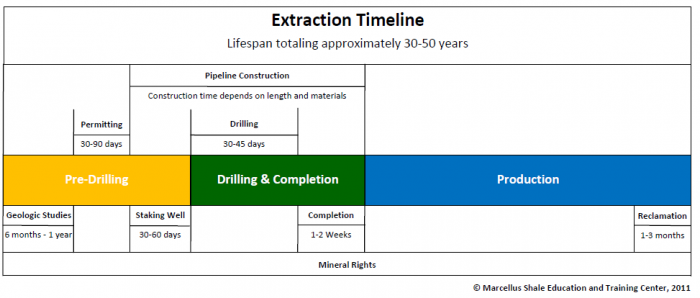Summary of the Phases of Shale Energy Development
The process to extract oil and gas from shale formations requires a significant amount of initial research to determine if the resources exist in recoverable quantities if they can be extracted with today's technology, and where the best locations are to drill from economic, environmental, and social perspectives. Once those initial aspects of exploring shale energy have been conducted, then companies will determine what areas to lease, and then ultimately drill and fracture wells. The table below provides an outline of the procedures and operations required to locate, drill, and complete a typical unconventional well, while the figure below indicates the average time required for each phase. As you can see the initial exploration work may take several years, drilling and fracturing may take several months, and production may last for several decades. We will explore each phase in greater detail in this and subsequent lessons.
| Exploration Phase (understanding the geology) | Leasing Phase (contracting with landowners) | Drilling and Fracturing Phase (the engineering and inspection) | Production Phase (the engineering and infrastructure) |
|---|---|---|---|
| 1. Basin-scale assessment (data analysis, available well information) | 1. Identifying "sweet spots" | 1. Apply for and receive necessary permits from state regulators | 1. Production and transmission of hydrocarbons |
| 2. Seismic data acquisition and interpretation | 2. Approaching landowners/owners of mineral rights | 2. Site preparation for well pad, pipeline, and water infrastructure | 2. Site restoration |
| 3. Securing a block of leases | 3. Rig setup and drilling operations | ||
| 4. Well construction and cementing | |||
|
5. Water supply, transfer, and storage operations |
|||
| 6. Well completion and testing |
